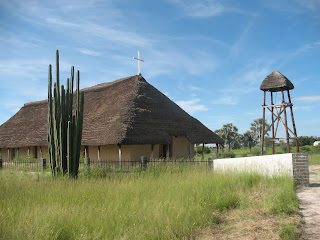 |
| Raucana falls |
I have spent the last three weeks away from Windhoek. The first two weeks were in northern Namibia doing homestays, going by the Namibian-Angolan border and seeing wild animals in Etosha National Park. Our studies continued in the northern regions through a wide range of speakers and tours. The structure of the trip was more casual then our time in South Africa and the Namibian coast. We consistently had two daily activities, with plenty of free time during the few hours around lunch. Our first night on Monday the 7th of March was spent at the Etuna Guest House, while the next eight were spent at our homestays in Oniipa. After that we went to Etosha National Park for two nights. During the day (except for the weekends) we had our activities and were dropped off to our homestays before dinner time.
Tuesday 8th
Omahenene Fishing project- A Spanish development endeavor selling fish products locally.
Raucana- Namibian-Angolan border town, houses the Raucana falls. I went across to the Angolan side for about 30 minutes but managed to whack my head into a branch later on which caused some bleeding. The falls at the peak of the rain season contained such a velocity of water and was extremely beautiful.
Wednesday 9th
Nakambale Museum- Contained the history of one of the first Finnish missionaries in Namibia and showed the traditional Oshivambo homestead in a full size walk through display.
Oshigambo Private Lutheran Secondary School- We engaged in a forum with grade 12 students on a range of different social issues.
Thursday 10th
 |
| Product at the Rural Development Centre |
Eudafano Factory- An operation that brings marula fruit from the community to be made into marula juice. It is a women’s development cooperative that maintains the juice making tradition.
Rural Development Centre at Ongwediva- A project selling a range of different products all made locally at the centre for inexpensive prices. The intent is for it to be sold to small scale farmers and business owners, to help develop the region.
Friday 11th
Ponhofi Secondary School- A school by the Namibian-Angolan border caught in the crossfire between South African forces and Namibian freedom fighters during the liberation struggle.
Oshikango- A Namibian-Angolan border town selling a range of goods and services to Angolans.
Saturday 12th
I spent the day with my homestay family, playing with my ten year old host sister, Lovi (we ran, danced, made up songs and did karate).
Sunday 13th
Consecration service- Went to the eight hour long church service for the newly elected bishops of the Evangelical Lutheran Church in Namibia (ELCIN). One of the two new bishops, Josephat Shangala was a friend of my parents. I also got to meet and converse with the Namibian president, Pohamba. The security guards tried to get us away from him as we were taking too much of his time, but he seemed happy to speak to us.
Monday 14th
 |
| Etunda Irrigation Project |
Etunda Irrigation Project- A local agricultural development project. Among the many different crops we got to see were bananas and cabbage (as it was such a drive it was the only activity of the day).
Tuesday 15th
Unam Northern Campus- The Oshakati campus of the University of Namibia. We got a tour and managed to see some of the central areas of the campus and learn about the university education system in Namibia.
Oshakati Town Council- We heard about development projects and problems with flooding in the Oshakati region.
Wednesday 16th
 |
| rhino |
Etosha Game drive- We drove through Etosha National Park to the place where we would be staying for two nights, Namutoni Resort. On the way we managed to see a number of interesting animals. It was my first time seeing most of them in the wild before. For example we spent some time watching three lions under the shade of a tree, but it was still a fair distance from us. We also spent some time watching a rhino as it slowly came closer and closer to us. Other key spotting were giraffes, zebras, springbok, impala, wildebeest, kudu, turtles, vultures, oryx, jackal and hyena.
Thursday 17th
Game drive- We had to wait till it was light enough to see animals but early enough to dusk, so that animals would be more often on the move. In the end it worked out pretty well. We managed to see some of the same animals from the previous day and a couple new ones like ostrich. We got to see a massive group of springbok (numbering somewhere over a hundred) and a fair group of grazing zebras.
Friday 18th
 |
| giraffe |
We headed on our way to Tsumeb to start spring break. Eleven of us got picked up in a kombi by our driver (Chanis) and host (Tara) to head to Victoria Falls. Five drove to the same destination in a rental car. The rest did other things for spring break. For example, three went down to Orange River, between the border of South Africa and Namibia to do kayaking.
Overall it was a truly valuable time of beauty and fellowship. More posts from this time period will be up soon to speak light into some of my experiences. Peace from Namibia!



























